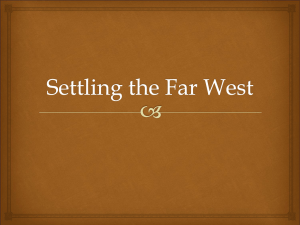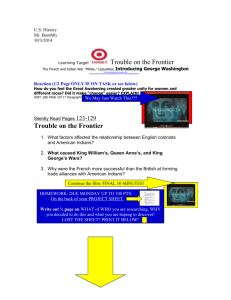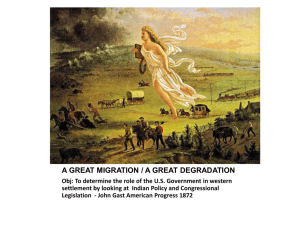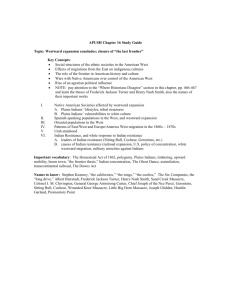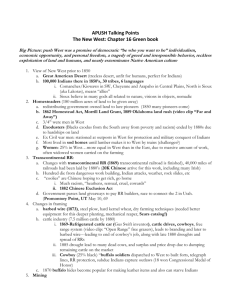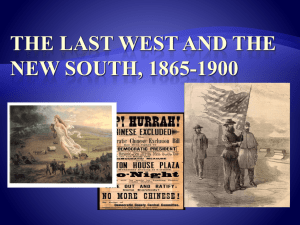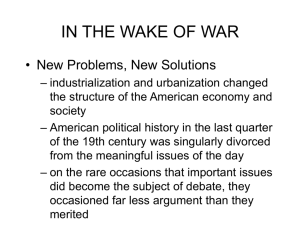chapter 5 The New South - Crestwood Local Schools
advertisement
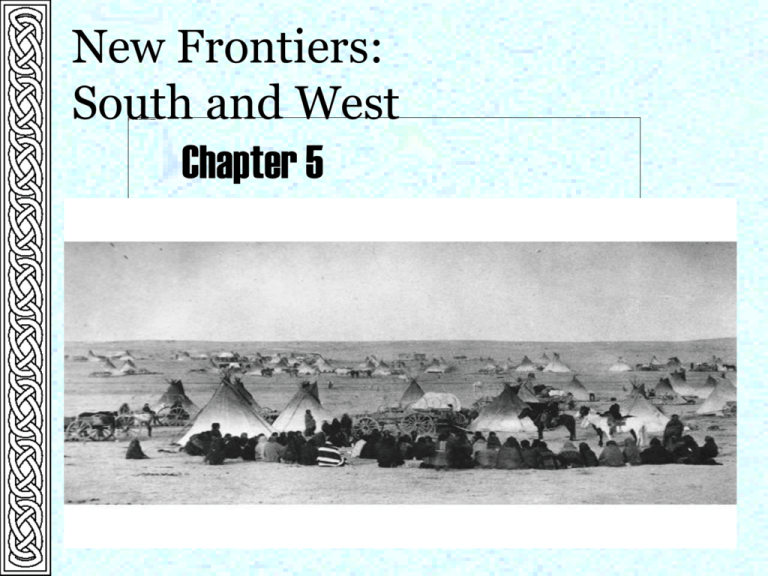
New Frontiers: South and West Chapter 5 The “New South” Henry Grady, editor of the Atlanta Constitution. In the 1880s, Grady argued for a “New South” based on industry, cities, and commerce. In short, to follow the North’s example and industrialize. But well into the century, Grady’s New South remained the poorest section of the country. The Southern Burden: Agriculture in the New South The economy of the postwar South remained agriculture, tied to crops such as tobacco, rice, sugar, and especially cotton. “King Cotton” dominated the economy The number of acres planted in cotton more than doubled between 1870 and 1900. Yet from 1880 to 1900 world demand The Southern Burden: Land ownership Sharecropping Made barely enough to live on. Tenant farming (crop-lien system) Borrowed against their harvests from merchant. Sharecropping, crop liens, and monopolies on ginning and marketing added up to inequality and crushing poverty for the South’s small farmers, black or white. Perpetual debt (credit price up to 60%) The Southern Burden: Tenancy and Sharecropping The Southern Burden: Southern Industry Boom in Textiles, Steel, Timber Tobacco and cigarettes 1876 – James Bonsack invented a machine to roll cigarettes. Suited new urban market in North – “clean, quick, and potent.” Between 1860 and 1900 Americans spent more money on tobacco than on clothes and shoes. By the 1890s American Tobacco Company led the industry. The Southern Burden: Summary The Sources of Southern Poverty Late start in industrializing Uneducated labor force Isolated southern labor market – did not attract outside investment Blacks and the New South Bourbon Redeemers – the (white) leaders of the Democratic party (In post-Civil War politics, habits of deference and elitism still prevailed). Disfranchisement of blacks in the South Designed to allow southern whites to divide politically without giving blacks the balance of power (Rise of populism in the 1890s challenged Democratic party). Mississippi Plan (1890) Residency requirement (hurt tenant farmers who moved around). Disqualified if convicted of crimes (often petty). Disqualified those who had not paid their poll taxes. Literacy requirement (“understanding” clause for whites who could not read the Constitution). Variations – 1898 Louisiana and Segregation (Racial) From 1875 to 1883 any racial segregation violated a federal Civil Rights Act. In 1883 the Supreme Court said that the 14th Amendment applied only to state sponsored discrimination. States could not require separate public facilities until 1896 when the Supreme Court upheld the policy of segregation in Plessy v. Ferguson, which upheld a Louisiana law requiring segregated railroad facilities. Separate but Equal Racial separation did not constitute discrimination, the Court argued, so long as accommodations for both races were equal. In reality, of course, such separate facilities were seldom equal. Soon Jim Crow statutes separated the races in almost all public places. The lynching of blacks in the South increased at about the same time that the Jim Crow laws spread through the South 1890-1899: 187 per year (82% in South) (32% Separate but Equal Black Response Booker T. Washington (accommodation) Argued that blacks should not antagonize whites by demanding social and political equality; instead they should concentrate on establishing an economic base for advancement. Became known as the Atlanta Compromise (speech in Atlanta in 1895) W.E.B. DuBois (protest) Criticized Washington and advocated a program of “ceaseless agitation” Urged blacks to challenge segregation and discrimination through social protest and political action. The “Frontier” Historian Frederick Jackson Turner (1890s) The West was defined as a westward-moving line “The meeting point of savagery and civilization.” For Turner, the frontier represented the march of progress into isolated areas of “free land” and was significant as a social safety valve, as the cradle of democracy, as a fountain of American self-reliance and sense of community. Modern historians have generally rejected Turner’s “frontier thesis.” The West was not one frontier but many with many regions and many groups of settlers and inhabitants. We will look at 4: Indians, miners, The Indian Wars (1864-1890) Report on the Condition of the Indian Tribes(1867) Congress decided that the best way to end Indian wars was to force the Indians to live on out-of-the-way reservations. The Great Sioux War Custer’s Last Stand - and the Indians’ Battle of Little Big Horn (1876) (Montana) Custer and 210 soldiers were annihilated by 2,500 Sioux and Cheyenne The Indian Wars (1864-1890) Indian wars virtually ended in 1886 with the capture of Geronimo (Apache chief). Chief Sitting Bull (Sioux) Battle of Wounded Knee, South Dakota (1890) Collapse of Indian resistance and the destruction of the buffalo herds. Killing with Kindness The Dawes Severalty Act (1887) Was designed to “Americanize” the Indians (individuals rather than tribes) Gave individual Indians up to 160 acres of land which, for the Indians’ protection, the government held in trust for 25 years Caused the Indians to lose over half of their land by 1934 Citizenship 1901 – Five Civilized Tribes of Oklahoma 1924 – All American Indians Miners (Gold, Silver, & Copper): Boom and Bust in the West The western boom began in 1849 with the California Gold Rush and the rise of San Francisco. Typical pattern The disorderly rush of prospectors was quickly followed by the arrival of the camp of followers: saloonkeepers, prostitutes, card sharps, hustlers, and desperadoes, out to mine the miners. All too often, busts followed booms, transforming boom towns into ghost towns. Once the quick profits were gone, a period of consolidation brought more order to towns. Boom and Bust in the West The growing demand for orderly government in the West led to the hasty creation of new territories and eventually the admission of states. The Transcontinental Railroad Before the railroad, travel across the West was slow and dusty. Central Pacific Railroad built the western link from Sacramento eastward and relied on 10,000 Chinese workers. Union Pacific Corporation built from Omaha westward using mainly Irish immigrants. Met at Promontory Point, Utah on May 10, 1869. The railroads controlled transportation Cattle Kingdom (Cowboys) Railroads opened the Great Plains to cattle drives that in the 1870s brought great herds to “cow towns” where they could be shipped to market. Chicago became the meat-packing center linked by railroad to the West. In 1869, a Chicago meat packer shipped the first refrigerated beef in an air-cooled car to Boston. 8 years later the system was perfected by Swift. The growth of the cattle industry placed a premium upon land. Conflicting claims over land and water rights ignited violent disputes between ranchers and farmers. Farmers Homestead Act of 1862 -- land could be purchased for $1.25 an acre or claimed free if you worked it for five years. Though land was relatively cheap, horses, livestock, wagons, wells, fencing, seed, and fertilizer was not. By the 1890s, an agrarian revolt was sweeping the South and West. In both sections disillusionment and despair turned to bitterness as more small farmers, black and white, found themselves enslaved to debt and driven toward bankruptcy, tenancy, and wage labor. Significant Events 1849-1859 Gold and sliver strikes open western mining frontier 1862 Homestead Act 1864 Chivington massacre 1869 Completion of first transcontinental railroad 1874 Barbed wire patented 1876 Battle of Little Big Horn 1879 Height of Exodus migration to Kansas 1887 Dawes Severalty Act 1890 Wounded Knee 1896 Plessy v. Ferguson upholds separate but equal doctrine Chapter 18

